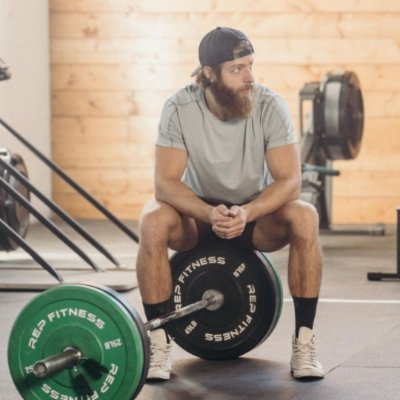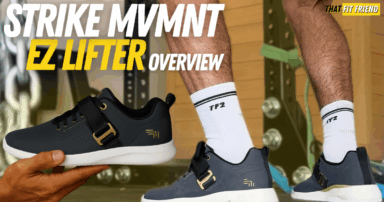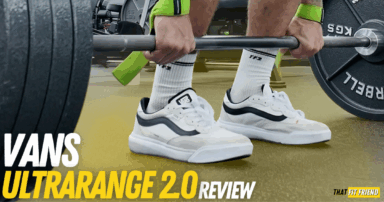That Fit Friend is supported by its readers. I [Jake Boly] run this site myself and buy the gear I review. If you purchase through my site, I may earn commissions on sales, read more here!
In my seven-plus years of reviewing cross-training shoes, few shoes have been more unique than the STR/KE MVMNT Transit Street Trainer and I express this A LOT in my YouTube review of these. When it comes to gym shoes, hybrid shoes are pretty common.
For example, we have countless dual-functionality training shoes that are built for running and lifting, HIIT and lifting, but never once have I reviewed a shoe for skating AND lifting.
I have long loved training my skate shoes, in fact, I used to solely lift in Vans when I started my strength training career way back when. However, Vans can feel clunky and that’s where the Transit Street Trainer starts to truly shine.
This model doesn’t feel as heavy as traditional skate shoes like Osiris and DC — all shoes I’ve lifted in before — and it’s a lot more pliable than traditional Vans and Converse. Here’s my detailed lifting and skating breakdown of the Transit Street Trainer.
Transit Street Trainer Specs to Know
- Heel-to-Toe Drop: 4mm
- Weight: 12.65 oz (for my size 10 model)
- Stack Height: N/A
- Removable Insole: Yes
- Width: Medium/Regular
- Sizing: True to size.
- Comparable To Haze Trainer: Read My Review
Sizing Thoughts
In the Transit Street Trainer, I’d suggest going true to size. I traditionally wear size 10 shoes and have around an E-width foot and these shoes fit my feet well.
I think if you have somewhat wide or medium/regular-width feet, then you’ll also enjoy the fit of these shoes. If you’ve worn STR/KE MVMNT Haze Trainers before, get the same size in the Transit as your Haze Trainers.
This model should work for wider feet, but keep in mind, that the suede upper will take time to break in. If you need wide-fitting shoes specifically built for training, I’d suggest checking out my training shoes for wide feet article.
Transit Street Trainer Toe Box Width
The Transit Street Trainer’s toe box is built to feel anatomical. It’s not as tapered as most traditional training shoes, and it feels wide enough for my E-width foot. I’d compare this shoe’s toe box most to the Haze Trainer and Adidas Dropset Trainer 2.
This shoe won’t be as wide as barefoot shoes so if you’re reading “anatomical” and thinking the Transit will be as wide as your favorite barefoot shoes I’m sad to say I’d temper your expectations there.
If you’re hesitant about this shoe’s width, I’d suggest buying through Box Basics (pro tip: they have easier returns than STR/KE) and making sure you keep your model clean in the event you need to return it.
Hot Take: I’ve loved this shoe, but I also recognize that it won’t be a shoe for everyone. If you have no desire to skate in this shoe and you’re not completely enamored by its appearance, then you might want to explore cross-training shoes specifically dialed for training.
Transit Street Trainer Performance Breakdown
To break down the performance of Transit Street Trainer, I pushed this shoe in a few key performance verticals. I was most interested in this shoe’s performance for lifting and cross-training and then I tested them for skating and casual wear.
Testing the Transit Street Trainer for Lifting and Cross-Training
The reason I opt(ed) for skate shoes when lifting was due to their stability and outsole grip. I think for most lifting and stability needs, the Transit Street Trainer should deliver in these verticals for most.
For stability testing context, I pushed this shoe with heavy squats and deadlifts. I Hatfield squatted 405 lbs in this model and deadlifted 475 lbs and never had glaring issues with the midsole compressing resulting in a loss of balance.
If you want this shoe primarily for general strength and hypertrophy workouts, then I think you’ll be fine with its stability. The SpectraFoam midsole isn’t crazy dense, but it will be “dense enough” for most lifters’ needs.
The outsole’s traction is also a perk for lifting because it bites well on pretty much all surfaces like wood, rubber gym floors, and turf, and this brings me to this shoe’s performance for cross-training.
This shoe is a lot more flexible than I thought it would be, and it was surprising how well it performed in things like broad jumps, kettlebell workouts, and sled work. It kind of reminds me of the RAD ONE with its bite, flexibility, and upper.
The forefoot and midfoot flex and articulate well which tends to be on par for most STR/KE MVMNT shoes. When digging into the forefoot and jumping forward, you notice the midsole flex and respond to the force you put into it. The upper security of this shoe also feeds well into cross-training. The suede upper blended with the mesh and neoprene gives this shoe a much more “athletic” feel on the feet. It’s worth noting the suede can run a little warm at times.
Would I use this shoe for CrossFit?
For CrossFit, this shoe can technically work and it reminds me a lot of the Vans UltraRange EXO and how a lot of CrossFit athletes rock them for their training. Will the Transit Street Trainer be the most dialed for things like rope climbing?
Not necessarily, but for most CrossFit WODs I see this shoe as being a fine pick and contending with more modern-day CrossFit shoes regarding its overall stability and responsiveness.
Testing the Transit Street Trainer for Skating
Before discussing this shoe’s performance for skating, I want to be clear: I am NOT a diehard skater, and I am very much a recreational skateboarder. I hadn’t skated until putting the Transit Street Trainers on and it’s been great getting back on my board.
I will say, though, I’m super grateful for getting back on my board and I’ve been skating again every day for the last month and I’ve missed it. I’m the type of skater who uses his board as a means of transportation and can do tricks like heelflips, kickflips, and 360 flips.
For my very much recreational skating needs, I’ve liked the Transit Street Trainer. I enjoy the midsole’s lightweight feeling and how this shoe has good flexibility for pushing off and doing tricks, and the width in its toe box is also solid.
I like that this shoe feels “lighter” than some of the DC shoes I’ve bought for skating casually over the last few years. Granted, that may be my bias and love for training shoes, but I do think if you’re similar about your skate shoes — in that, you love flexibility and lighter shoes — then you’ll resonate with the Transit Street Trainer’s on skateboard feeling.
I have noticed some ripping of the mesh towards the top of the collar from heelflips, however, I think most of that is due to my heelflip form being a little dodgy.
Testing the Transit Street Trainer for Walking and Comfort
Outside of training, I’ve worn the Transit Street Trainer a ton for walking and casual wear. These have been some of my primary go-to shoes for dog walks, running errands, and wearing to work meetings.
I’ve been keeping loose track, but as of right now, I’ve logged about 60 miles of walking/15 miles of running in the Transit Street Trainer. For walking, this shoe’s main perks include its SpectraFoam midsole and comfortable heel construction. I wear my model looser when walking and I like how easy they are to slip on and off.
In this context, the lower-profile upper and tongue gusset plays well into the casual wear nature of this shoe. They give this model a secure feeling without feeling overbearing and having to crank the laces super tight. As a “lazier” person, I appreciate this as I tend to resonate with daily driver shoes that are easy to wear looser.
I’ve run a bit in this shoe when intervals were programmed into my full-body workouts, and I haven’t despised this shoe for runs that were between 400 to 800 meters. This model is “light enough” for this running task, but I wouldn’t rock this shoe for runs longer than a mile. I think for that distance this shoe could start to feel a little blocky.
Overall, the Transit Street Trainer has been a viable training and skating shoe for casual wear. It looks good, has a comfortable fit, and its midsole is plush enough to be comfortable for walking 2-4 miles at a time. I can also see this shoe being a good fit for anyone who’s on their feet all day for work.
Construction Close-Up
Outsole
The Transit Street Trainer’s outsole is built with a Variable Platform outsole. The tread on this shoe varies and is designed to promote traction on different surfaces when moving in different directions. I like the outsole build of this shoe and as mentioned in my performance section find it does a good job promoting grip.
Midsole
The SpectraFoam midsole is completely enclosed in the rubber outsole that wraps the forefoot and midfoot of this shoe. I like this because it protects the foam from breaking down from the friction of grip tape and training. Compared to other training shoes, this model’s midsole density and feel are most similar to shoes like the Reebok Nano X4.
Upper
There’s Clarino Ultrasuede paneling that wraps around the forefoot and heel of this shoe. This material has a heavier and smoother feeling to it and it does a good job with security promotion. The midfoot and heel feature a blend of mesh, knit, and neoprene. The midfoot feels softer and the memory foam collar in the boot has good security and a comfortable fit.
Tongue and Laces
The padded mesh tongue in the Transit Street Trainer features a lace pocket which is something most STR/KE MVMNT shoes have. This is nice to have for tucking your laces when skating and training. This model has five core eyelets with two tongue loops and a gusset for additional security.
STR/KE MVMNT Transit Street Trainer Final Verdict
There are a lot of unique construction features that come along with the Transit Street Trainer. Two features in particular stand out to me with this shoe and this includes the SpectraFoam midsole and Clarino Ultrasuede upper/memory foam collar.
The midsole in this shoe has been great because it feels more pliable and flexible than traditional skate shoe midsoles. You can lift heavy in these shoes but also cross-train in them and they feel responsive and flexible.
This is great because it adds to this shoe’s range in the gym and it keeps it moderately comfortable for skating, giving you enough cushion to absorb landings. I haven’t skated in years, and this shoe felt great on the feet when getting back in 360 flips and kickflips (self-five!).
The suede upper and memory foam collar has been great for comfort, appearance, and security. When skating and doing things in the gym like jogging, jumping, and agility work, this shoe has “felt” like a traditional training shoe, which was a nice surprise. I went into this shoe assuming it would be clunky like a skate shoe, so it’s been nice finding the opposite.
The bottom line is I think if you want that versatile hybrid shoe for daily wear, some skating, and lifting, the Transit Street Trainer will deliver for you.
It’s not the most dialed shoe for any single activity so if you keep that in mind before buying then this shoe is a sound investment and will meet your expectations.
If you have additional questions about the Transit Street Trainer, drop a comment below or reach out to me via Instagram (@jake_boly or @that_fit_friend).



















Emilio
What do you think of these shoes for basketball? Full court, half, or both?
Could work for some casual games, but wouldn’t be my first pick if you want a model purely for basketball! Grip and midsole should work, though.